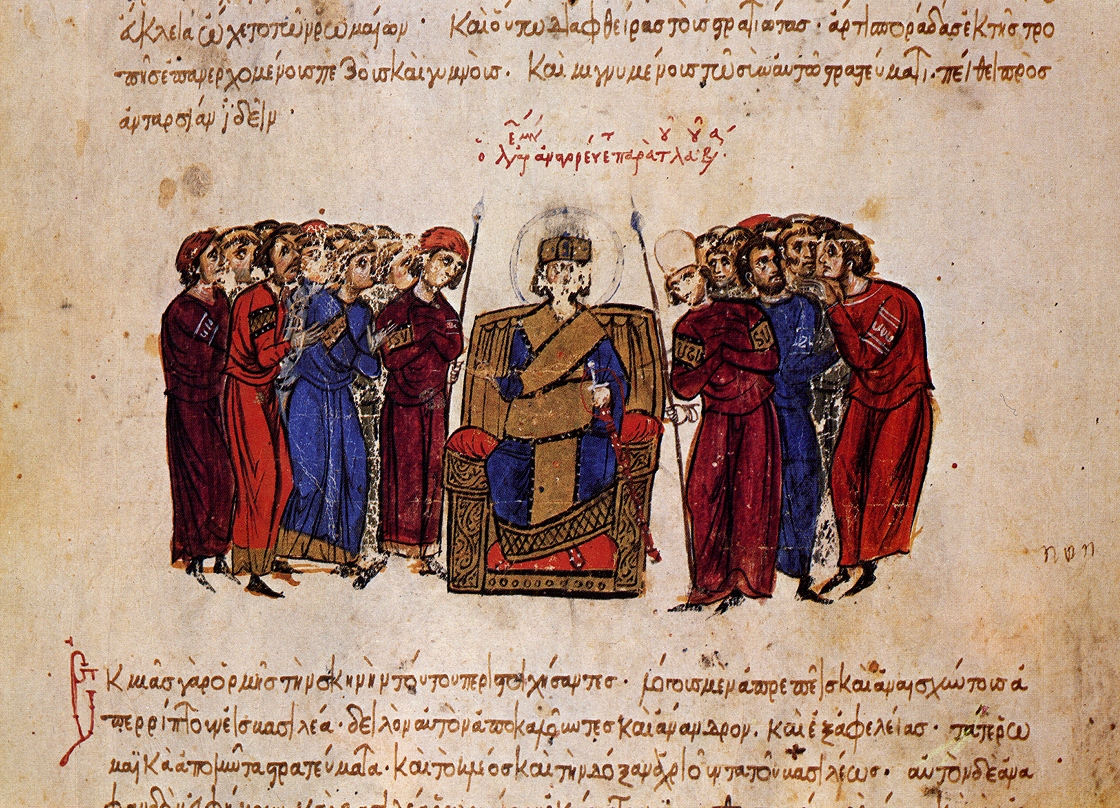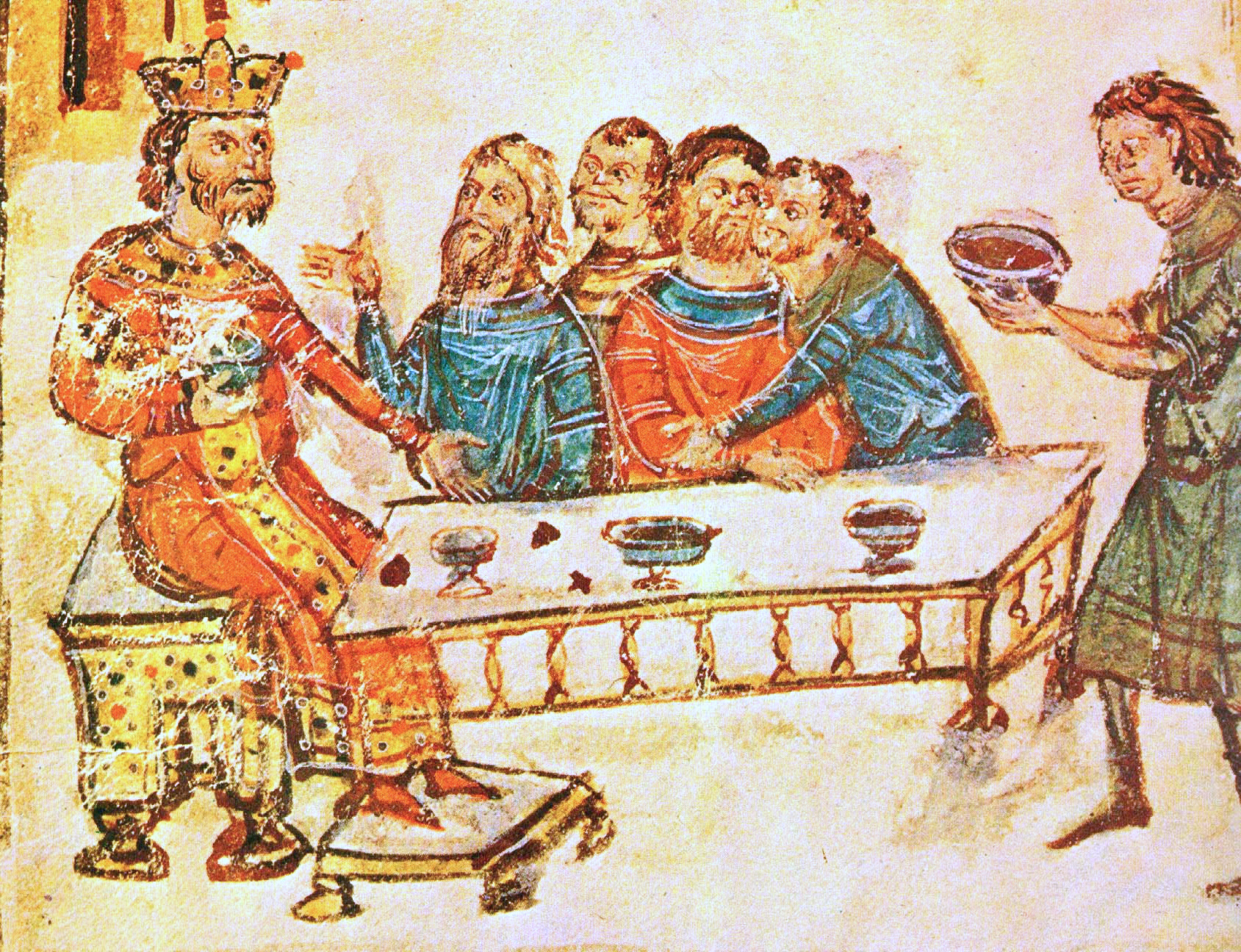|
Leo V The Armenian
Leo V the Armenian ( gr, Λέων ὁ ἐξ Ἀρμενίας, ''Leōn ho ex Armenias''; 775 – 25 December 820) was the Byzantine emperor from 813 to 820. A senior general, he forced his predecessor, Michael I Rangabe, to abdicate and assumed the throne. He ended the decade-long war with the Bulgars, and initiated the second period of Byzantine Iconoclasm. He was assassinated by supporters of Michael the Amorian, one of his most trusted generals, who succeeded him on the throne. Life Leo was the son of the patrician Bardas, who was of Armenian descent (according to Theophanes Continuatus, Leo was also of Assyrian that is Syrian descent). Leo served in 803 under the rebel general Bardanes Tourkos, whom he deserted in favor of Emperor Nikephoros I. The Emperor rewarded Leo with two palaces, but later exiled him for marrying the daughter of another rebel, the patrician Arsaber. On the other hand, a contemporary source says that one general Leo of the Armeniakon theme was punishe ... [...More Info...] [...Related Items...] OR: [Wikipedia] [Google] [Baidu] |
Solidus (coin)
The ''solidus'' (Latin 'solid'; ''solidi'') or nomisma ( grc-gre, νόμισμα, ''nómisma'', 'coin') was a highly pure gold coin issued in the Late Roman Empire and Byzantine Empire. Constantine introduced the coin, and its weight of about 4.5 grams remained relatively constant for seven centuries. In the Byzantine Empire, the solidus or nomisma remained a highly pure gold coin until the 11th century, when several Byzantine emperors began to strike the coin with less and less gold. The nomisma was finally abolished by Alexius I in 1092, who replaced it with the hyperpyron, which also came to be known as a "bezant". The Byzantine solidus also inspired the originally slightly less pure dinar issued by the Muslim Caliphate. In Western Europe, the solidus was the main gold coin of commerce from late Roman times to Pepin the Short's currency reform, which introduced the silver-based pound/ shilling/ penny system. In Late Antiquity and the Middle Ages, the sol ... [...More Info...] [...Related Items...] OR: [Wikipedia] [Google] [Baidu] |
Theophanes The Confessor
Theophanes the Confessor ( el, Θεοφάνης Ὁμολογητής; c. 758/760 – 12 March 817/818) was a member of the Byzantine aristocracy who became a monk and chronicler. He served in the court of Emperor Leo IV the Khazar before taking up the religious life. Theophanes attended the Second Council of Nicaea in 787 and resisted the iconoclasm of Leo V the Armenian, for which he was imprisoned. He died shortly after his release. Theophanes the Confessor, venerated on 12 March in both the Eastern Orthodox and the Roman Catholic churches, should not be confused with Theophanes of Nicaea, whose feast is commemorated on 11 October. Biography Theophanes was born in Constantinople of wealthy and noble iconodule parents: Isaac, governor of the islands of the Aegean Sea, and Theodora, of whose family nothing is known. His father died when Theophanes was three years old, and the Byzantine Emperor Constantine V (740–775) subsequently saw to the boy's education and upbringing a ... [...More Info...] [...Related Items...] OR: [Wikipedia] [Google] [Baidu] |
Constantinople
la, Constantinopolis ota, قسطنطينيه , alternate_name = Byzantion (earlier Greek name), Nova Roma ("New Rome"), Miklagard/Miklagarth (Old Norse), Tsargrad ( Slavic), Qustantiniya ( Arabic), Basileuousa ("Queen of Cities"), Megalopolis ("the Great City"), Πόλις ("the City"), Kostantiniyye or Konstantinopolis ( Turkish) , image = Byzantine Constantinople-en.png , alt = , caption = Map of Constantinople in the Byzantine period, corresponding to the modern-day Fatih district of Istanbul , map_type = Istanbul#Turkey Marmara#Turkey , map_alt = A map of Byzantine Istanbul. , map_size = 275 , map_caption = Constantinople was founded on the former site of the Greek colony of Byzantion, which today is known as Istanbul in Turkey. , coordinates = , location = Fatih, İstanbul, Turkey , region = Marmara Region , type = Imperial city , part_of = , length = , width ... [...More Info...] [...Related Items...] OR: [Wikipedia] [Google] [Baidu] |
Krum Of Bulgaria
Krum ( bg, Крум, el, Κροῦμος/Kroumos), often referred to as Krum the Fearsome ( bg, Крум Страшни) was the Khan of Bulgaria from sometime between 796 and 803 until his death in 814. During his reign the Bulgarian territory doubled in size, spreading from the middle Danube to the Dnieper and from Odrin to the Tatra Mountains. His able and energetic rule brought law and order to Bulgaria and developed the rudiments of state organization. Biography Origins Krum was a Bulgar chieftain from Pannonia. His family background and the surroundings of his accession are unknown. It has been speculated that Krum might have been a descendant of the old Bulgar royal house of Kubrat. The name Krum is of Turkic origin and means "governor prince" (from ''kurum'' "rule, leadership, administration"). Establishment of new borders Around 805, Krum defeated the Avar Khaganate to destroy the remainder of the Avars and to restore Bulgar authority in Ongal again, the tradit ... [...More Info...] [...Related Items...] OR: [Wikipedia] [Google] [Baidu] |
Chalke Gate
The Chalke Gate ( el, ), was the main ceremonial entrance (vestibule) to the Great Palace of Constantinople in the Byzantine period. The name, which means "the Bronze Gate", was given to it either because of the bronze portals or from the gilded bronze tiles used in its roof. The interior was lavishly decorated with marble and mosaics, and the exterior façade featured a number of statues. Most prominent was an icon of Christ which became a major iconodule symbol during the Byzantine Iconoclasm, and a chapel dedicated to the ''Christ Chalkites'' was erected in the 10th century next to the gate. The gate itself seems to have been demolished in the 13th century, but the chapel survived until the early 19th century. History The gate lay on the southeastern corner of the Augustaion, the main ceremonial plaza of the city, with the Hagia Sophia cathedral on the northern side and the Baths of Zeuxippos and the Hippodrome of Constantinople on the southern and western sides. The firs ... [...More Info...] [...Related Items...] OR: [Wikipedia] [Google] [Baidu] |
Iconoclasm (Byzantine)
The Byzantine Iconoclasm ( gr, Εικονομαχία, Eikonomachía, lit=image struggle', 'war on icons) were two periods in the history of the Byzantine Empire when the use of religious images or icons was opposed by religious and imperial authorities within the Orthodox Church and the temporal imperial hierarchy. The First Iconoclasm, as it is sometimes called, occurred between about 726 and 787, while the Second Iconoclasm occurred between 814 and 842. According to the traditional view, Byzantine Iconoclasm was started by a ban on religious images promulgated by the Byzantine Emperor Leo III the Isaurian, and continued under his successors. It was accompanied by widespread destruction of religious images and persecution of supporters of the veneration of images. The Papacy remained firmly in support of the use of religious images throughout the period, and the whole episode widened the growing divergence between the Byzantine and Carolingian traditions in what was still a u ... [...More Info...] [...Related Items...] OR: [Wikipedia] [Google] [Baidu] |
Patriarch Nicephorus I Of Constantinople
Nikephoros I or Nicephorus I (c. 758 – 5 April 828) was a Byzantine writer and patriarch of Constantinople from 12 April 806 to 13 March 815. Life He was born in Constantinople as the son of Theodore and Eudokia, of a strictly Orthodox family, which had suffered from the earlier Iconoclasm. His father Theodore, one of the secretaries of Emperor Constantine V, had been scourged and banished to Nicaea for his zealous support of Iconodules, and the son inherited the religious convictions of the father. Nevertheless, he entered the service of the Empire, became cabinet secretary (''asekretis''), and under Irene took part in the synod of 787 as imperial commissioner. He then withdrew to one of the cloisters that he had founded on the eastern shore of the Bosporus, until he was appointed director of the largest home for the destitute in Constantinople c. 802. After the death of the Patriarch Tarasios of Constantinople, although still a layman, he was chosen patriarch by the ... [...More Info...] [...Related Items...] OR: [Wikipedia] [Google] [Baidu] |
Battle Of Versinikia
The Battle of Versinikia ( bg, Битката при Версиникия; el, Μάχη της Βερσινικίας) was fought in 813 between the Byzantine Empire and the Bulgarian Empire, near the city of Adrianople (Edirne). While the Bulgarians, led by Krum, had an army about half the size of the Byzantine Empire, they were victorious, resulting in the dethroning of Byzantine Emperor Michael I Rangabe (811–813) by Leo V the Armenian. The battle was a major success for the Bulgarians and further strengthened the Bulgarian position after their victory over Nicephorus I two years earlier. After the battle they took ''de facto'' control of the whole of Eastern Thrace (until the Byzantine–Bulgarian Treaty of 815) with the exception of a few castles that remained in Byzantine control. For the first time in Bulgarian history, the way to Constantinople was opened. Krum died at the height of the preparation for the final siege of the Byzantine capital on the 13th of April ... [...More Info...] [...Related Items...] OR: [Wikipedia] [Google] [Baidu] |
Thabit Ibn Nasr
Thabit ibn Nasr ibn Malik al-Khuza'i () (died 813/14) was an Abbasid general and governor of the Cilician frontier zone ('' al-thughur al-Sha'miya'') with the Byzantine Empire in 808–813. Thabit was a native of Khurasan, and the grandson of Malik ibn al-Haytham al-Khuza'i, an early Abbasid follower and military leader. He was appointed as governor of the Syrian '' thughur'' (essentially comprising Cilicia, with Tarsus as its capital) in the last year of the reign of Harun al-Rashid (808/9).Crone (1980), p. 182 He organized a prisoner exchange with the Byzantines at Podandos in 808, but also led a series of raiding expeditions (''sawa'if'') against them. In one of these however, in August 812, he suffered a heavy defeat at the hands of Leo the Armenian, losing 2,000 men. From ca. 810, with the outbreak of a civil war between al-Amin Abu Musa Muhammad ibn Harun al-Rashid ( ar, أبو موسى محمد بن هارون الرشيد, Abū Mūsā Muḥammad ibn Hārūn al-Rashī ... [...More Info...] [...Related Items...] OR: [Wikipedia] [Google] [Baidu] |
Arab
The Arabs (singular: Arab; singular ar, عَرَبِيٌّ, DIN 31635: , , plural ar, عَرَب, DIN 31635: , Arabic pronunciation: ), also known as the Arab people, are an ethnic group mainly inhabiting the Arab world in Western Asia, North Africa, the Horn of Africa, and the western Indian Ocean islands (including the Comoros). An Arab diaspora is also present around the world in significant numbers, most notably in the Americas, Western Europe, Turkey, Indonesia, and Iran. In modern usage, the term "Arab" tends to refer to those who both carry that ethnic identity and speak Arabic as their native language. This contrasts with the narrower traditional definition, which refers to the descendants of the tribes of Arabia. The religion of Islam was developed in Arabia, and Classical Arabic serves as the language of Islamic literature. 93 percent of Arabs are Muslims (the remainder consisted mostly of Arab Christians), while Arab Muslims are only 20 percent of the ... [...More Info...] [...Related Items...] OR: [Wikipedia] [Google] [Baidu] |






